|
FAQs on Bulb, Bubble Tip/Rose Anemone
Behavior 3
Related Articles: Bubble
Tip, Rose Anemones, Entacmaea quadricolor, Use in Marine
Systems by Bob Fenner, Bubble Tip
Anemones by Jim Black, Recent
Experiences with BTA's by Marc Quattromani,
Anemones,
Cnidarians, Colored/Dyed Anemones,
Related FAQs: BTA Behavior 1, BTA
Beh. 2, BTA Beh. 4, &
E.
quad. FAQ 1, E. quad FAQ 2,
E. quad. FAQ 3, E. quad FAQ 4, E.
quad FAQ 5, BTA
ID, BTA Compatibility, BTA Selection, BTA
Systems, BTA Feeding, BTA Disease, BTA
Reproduction/Propagation,
Anemones, Anemones 2,
Caribbean
Anemones, Condylactis,
Aiptasia
Anemones, Anemones and
Clownfishes, Anemone
Reproduction, Anemone
Lighting, Anemone
Identification, Anemone
Selection, Anemone Behavior,
Anemone
Health, Anemone
Placement, Anemone
Feeding, Heteractis malu,
|
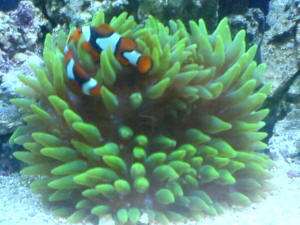
|
 |
New Print and
eBook on Amazon:
Anemone Success
Doing what it takes to keep Anemones healthy long-term
by Robert (Bob) Fenner
|
Bubble Anemone Upside-down/BTA Behavior
10/21/11
Hi,
<Hello John>
I bought a green bubble anemone a week ago and when I put it in the
tank, it was on the top edge of a large flat live rock. That night it
moved underneath the rock edge and has been there ever since... still
in full view. It eats fine, mouth is fine, and my maroon clown is
hosting it. I feed it silversides, squid, and mysis shrimp. I was just
wondering if it was okay for it to hang upside down? Or should I try
relocating it back to the top of the rock? Water parameters are all
good and 0.
<Leave it alone, it moved to an area more favorable to it, may even
move again. Do read here for more info on BTAs.
http://www.wetwebmedia.com/marine/inverts/cnidaria/anthozoa/bubbletipanemones.htm>
Thanks,
<You're welcome. James (Salty Dog)>
John
|
BTA Strange White Projections, beh.
f' 8/17/11
Good morning,
<Ryan>
Attached is a photo of the phenomenon I'm trying to
decipher.
My Rose Bubble Tipped Anemone has five very thin, antenna-like
projections this morning that appear to protrude from its
mouth.
The 24-gallon tank had been established with the BTA, its pair of
clowns, and live rock a few months prior to its setup in my house
in June of this year. The BTA split almost two weeks ago now; the
new clone is less than two inches in diameter and the original
measures between four and ten inches.
This week I added copepods (that I might introduce a goby soon),
and a skunk cleaner shrimp. Other inhabitants include a blue
damsel, lots of Kenya trees, and snails. There is only a small
amount of green algae in the sand bed along the glass.
Today, I washed my mechanical (sponge) filter, replaced the
carbon, did a nearly 20% water change, and tested the nitrate at
less than 5ppm.
This morning, I found the aforementioned projections, four of
which were resting near the new clone. They don't appear
curly or waste-like, in fact, they appear similar to my skunk
shrimp's antennae. The clown was swimming happily around them
and all of my inhabitants are accounted for.
My only explanation is that I've never seen my BTA at 2a.m.
Can you help me?
<I think so. These appear to be "mesenterial
filaments"... do get extended into water column following
stimuli of various sorts... e.g. a searching, food-drawing
behavior. Not problematical. BobF>
Thank you,
Ryan
|
|
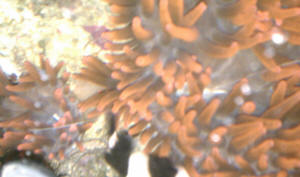
|
Anemone with no tentacles
8/9/11
I have a question today regarding my rbta. This anemone has been in my
tank for a couple of months now and has been doing excellent. Never
moved much around the tank and has always stayed firmly attached to a
rock. About a week ago it stayed closed for over a day and when it
opened back up it had very few tentacles. It isn't like it lost
them, just that they had shrunken and moved into the foot.
<Can/will do this under very adverse conditions... Let's see
what else is in this tank, how close/proximal it is...>
Now it has been like this for a week. It is open but has very few
tentacles that extend out from the foot. I took the host maroon clown
out and put him in my refugium for now to hopefully let him
recover.
<Good idea/move>
There is no other signs of anything wrong with the tank and all of the
water parameters are normal as they have always stayed. I feed him
about every three days a small chunk of silverside. I have slowed this
since he has been looking ill to about once a week. I have plenty of
light coming from a homemade led at over two led watts per gallon.
<Mmm, this really isn't much in the way of intensity>
I did about a fifty percent water change yesterday to help if there was
anything I missed in water quality. I am stumped. Have you ever heard
of this before and how could I help it?
<I have... again, what other livestock is present? Other Cnidarians?
Have you searched, read on WWM re Entacmaea behavior,
compatibility?>
Thanks in advance for any info.
<Welcome. Bob Fenner>
Re: Anemone with no tentacles 8/9/11
I have read through the behavior areas on Entacmaea quadricolor and
have not found much about what mine is doing. I have also gone through
the compatibility and the only other thing in the tank that could be a
problem is a purple tipped frogspawn.
<Mmm, yes... IF this is close by, in a small volume, either is
stressed>
The frogspawn is a small piece with only a few small heads on it. I
never see anything picking at it or eating on it.
Do you think I should add some more light to the tank for this
specimen?
<Yes I would>
I did research through forums before building my LED and came up with
the plan for this light. The lumen output is compatible to outfitting
the tank with metal halides.
<What is the PAR value near this animal?>
Do I continue feeding, is there anything else I can do besides just
wait and see if it comes back?
<Continue to feed, broaden diet, add Iodide-ate...>
Any suggestions are greatly appreciated. Thanks again for the great
website. It is a huge help to aquarists.
<Do peruse the rest of the materials archived on WWM re this
species.
Perhaps "something will pop-up" that doesn't occur to
either of us presently. BobF>
BTA behavior 8/4/11
Good morning, crew.
I'm writing today to inquire about some behavior in my rose bubble
tip that seems counter-intuitive to everything that I've read about
them.
I've had the specimen in my system for about two months now. It is
being hosted by a pair of tomato clowns, and came firmly attached to a
large piece of rubble. The retailer had him in a shallow tank with a
relatively low level of T-5 lighting.
To properly acclimate him, I used the drip method. To insure the BTA
didn't bleach (I'm using pretty strong LEDs), I placed it's
rock on the sandbed and gradually moved it up. When I got it to the
position I wanted it (about half-way up the tank), I left it. My system
parameters are pristine, with a SG of 1.026, 0
nitrates/nitrites/ammonia, 0 phosphates, <... this animal needs
some/measurable NO3, HPO4>
temperature drops to 79 at night and gradually rises to a hair under 81
during the day. The BTA has been eating a varied diet of vitamin
enriched frozen silversides and krill, being fed every three to four
days.
My question concerning its behavior is this: why, in a spot with more
PAR (measured at about 320 where it is), is it expanding more than
where the lighting was less intense?
<Driven photosynthesis>
Everything I've read seems to indicate that BTA's will expand
more to make better use of the available light,
<Up to a point; saturation... and/or limits of nutrient
availability, other factors>
but in just two months, it has gone from about 2 inches inflated and
expanded to about 7 inches. It didn't seem likely that it had
simply grown this much.
<Mmm, nope; just inflation, more water>
Thank you for satisfying my curiosity.
-Dustin
<Hope I have. Otherwise you might enjoy and gain by reading:
http://wetwebmedia.com/BTABehF3.htm
and the linked files above. Bob Fenner>
re: BTA behavior 8/4/11
Thank, Crew, for the response. You mentioned that bubble tip's need
a small, measurable amount of nitrate and phosphate (as I have been
told about many organisms, including various soft corals).
<Mmm; yes; most all photosynthates>
What's a good method for maintaining control of this while allowing
a small amount of nutrients to exist in the system?
<Just to not be too fastidious re "maintenance", cut back
on, eschew the use of chemical filtrants>
I have a Biocube 29,
<Mmm, really too small for Entacmaea>
running a CPR SR3 skimmer in the middle compartment, a bag of
Chemi-Pure Elite and a bag of Purigen. Am I just overdoing it
on the filtration?
<Yes... I'd at least allow these chemical units to "get
olde"; only replace every two-three months>
The bio-load isn't too heavy right now, as my fish include only the
two juvenile Tomato Clownfish (each around 2 inches in length) and a
Coral Beauty that is about 3 inches. My cleaning crew is 3 Peppermint
Shrimp, 1 Skunk Cleaner, 3 Ceriths, 3 Astreas, 2 Nassarius snails, and
12 hermits (a mix of red and blue legged). I have 2-2.5 inch shallow
sand bed, and about 25lbs of live rock for additional biological
filtration.
Does it seem plausible that I could do without the chemical
filtration?
<Not likely, no; with the amount, kinds of life here in such a small
volume>
Would that be likely to allow a lower, reasonable amount of nutrients
to remain in the tank?
<Not likely so, no>
I also have a small amount of Stylophora and a single Trachyphyllia
specimen...would they be negatively affected by allowing my Nitrate
levels to rise to around 3-4ppm?
<They would not be; however the presence of other compounds produced
by the Cnidarians here might lead to allelopathogenic effects. See WWM
re mixing:
http://wetwebmedia.com/CorlCompArt.htm
and/or the linked files above, a search re the species you're
dealing w/>
Thank you again,
Dustin
<Welcome. BobF>
|
RBTA Help Please/Entacmaea
quadricolor/Systems/Behavior/Recipe For Disaster
8/2/11
Dear Wet Web Media,
<Hello James>
First I would like to thank you for your help and splendid
website.
<You're welcome.>
I have searched all over the internet and all over your site and
I can't find any information in regards to my Rose Bubble Tip
Anemone.
<Is the same as Entacmaea quadricolor, just a different color
variation.>
To provide some background information I have a 12 gallon
JBJ Nano cube.
<Much too small for this anemone.>
It has been set up for 5 months now. In it is 20lbs of live sand,
20 lbs of live rock, 6-8 Scarlet Reef Hermits, 5 Astrena
<Astrea> Snails, 1 Turbo Snail, 5-6 different mushrooms, 4
different Zoa colonies, a Kenya Tree, a Duncan, a Maze Brain
frag, a Brown Birdsnest frag, a small Peppermint Shrimp, A large
Cleaner Shrimp, a Coral Beauty Angelfish,
<Too small a volume for this fish as well.>
and 2 False Percula Clown Fish (who host in the Duncan), and I
recently added a RBTA. My wife and I were given 2 RBTA but we
kept the smaller and traded the other. As far as I can tell its
tentacles bubble up really well and it looks healthy, except for
the fact that it is not centered on its foot, and on one side it
has some purple frilly stuff coming out from the bottom and it
also has yellow stretch marks on it. I know my water parameters
are not the best but they are improving.
My nitrates <20,
<Too high.>
nitrite 0, alkalinity 300, ph 8.2 I acclimated the anemone for
well over 2 hours, and it has attached itself to the rock near
the bottom of the tank. I haven't fed it yet, but it expelled
some brown pellet looking balls earlier today. I am nervous
because I am still new to the hobby. I don't know if it is
splitting or if it is sick. Any information would be greatly
appreciated.
<Is a normal reaction when moved to a new
environment. I suggest trading the BTA or find an
acceptable home for it. Your system is much too small for success
with this animal, and all other Cnidarians will be at risk should
the BTA decide to move, and likely it will. When the BTA dies, if
unnoticed, you will assuredly have a complete wipe out....not
worth the risk.
Please read here.
http://www.wetwebmedia.com/marine/inverts/cnidaria/anthozoa/bubbletipanemones.htm
Thanks For all of your help!
<You're welcome. James (Salty Dog)>
James
Oops, sorry Jamie for addressing you as James. My oversight and
you can call me Jamie if you would like. :-)
James (Salty Dog)
|
|
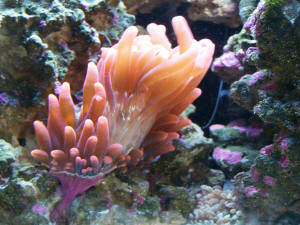 
|
|
Re RBTA Help Please/Entacmaea
quadricolor/Systems/Behavior/Recipe For Disaster 8/2/11-
8/3/11
James
<Jamie>
Not a problem I go by either. But my real question was, what are
the yellow stress or stretch lines on the anemone, and also the
purple frilly stuff coming out of the bottom (is that it growing
another foot?)?
<The "stress" lines are likely wrinkles, the anemone
is deflated somewhat.
Not growing a foot but may be debris from a previous anchor or
the anemone may have been injured when it was removed from your
dealer's tank. Not enough resolution in the image to
discern.>
Also, you said "when it dies", are you implying that
the animal is sick now, or it will die someday?
<No, not sick now but very likely will not adapt to the
environment it is presently in.
Do keep a close eye on it if you decide on keeping it.>
<<Is dying; quite quickly... RMF>>
hanks again for your prompt responses. The link that you
recommended was very informative.
Thanks,
<You're welcome. James (Salty Dog)>
Jamie
Re RBTA Help Please/Entacmaea
quadricolor/Systems/Behavior/Recipe For Disaster
8/4/11
My plans are to keep it until it splits, I do not feel
comfortable trying to peel it off the rock that it is attached to
because I fear that I will tear the foot. I have see a few people
with RTBA in a 12g or smaller tank and it was doing just
fine.
Thanks again for your help!
<You're welcome. James (Salty Dog)>
James
|
|
Anemone Tentacle Torsion
7/4.5/11
WWM Crew,
<Ed>
Attached picture is close-up of the base of a tentacle on my
Green BTA.
The tentacle seems to be twisted up on itself very tightly ....
like intestinal bloat.
<Have seen this on numerous occasions... but don't know
what it portends>
Earlier, I gently wafted the tentacle with a gloved hand to
encourage it to untwist. A bubble of brown goop ( likely
Zooxanthellae? ) came off of the torsion area and the tentacle
deflated but still remains twisted.
Have any of you had this happen and what, if anything, should I
do to limit any further damage to the BTA or future
occurrence.
Thank you,
Edward
<Almost always anemones recover from these events... sometimes
the one or several involved tentacles pinch off... At other times
they reinflate.
Cheers, Bob Fenner>
|
|
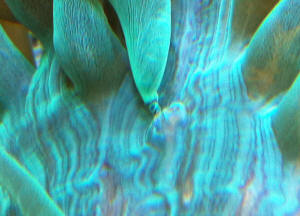
|
RBTA issues/BTA Behavior
7/3/2011
I have been searching through the site for information on Rose Bubble
Tip Anemones. I recently purchased one and have a similar problem to
that of many other new anemone owners. I acclimated it to the tank
through the drip method and placed it on a center rock where I thought
it might be happy.
It immediately took hold with its foot and stayed there for a few
hours. It then moved across that rock and down into a crevice between
that piece of rock and another. Through all of my readings I know that
I most likely shouldn't move it but here is where my situation is a
little different.
Where he moved down to is a spot that the rocks aren't the most
stable and I am afraid that if I bump one of the rocks while doing
anything in the tank that he will be crushed. Plus, I can not get
anything into where he is at to feed him anything. He is now on the
complete underside of the crack between the rocks with probably ninety
percent of his body, and a few tentacles are still sticking out the top
of the crack. I feel like he may be moving away from my lights, I have
a home made LED set up that has 15, 3 watt Cree LEDs on it. He does
still look happy and healthy, good color and nice bulbs, the little
tiny bit that I can see of him. My question is do I try to separate the
two rocks and move him out of harms way or do I just leave him and hope
that he makes his way back up shortly as he gets more use to the
tank.
<This behavior is not unusual for newly introduced BTAs, they do
prefer protecting their column by wedging into crevices. I would not
try to move the anemone, give it some time, it will likely move again
to a more favorable position. If you feel you must move it, move the
rock the anemone is attached to and place it in an area with smaller
rocks surrounding the rock it is attached to.
I suggest reading here if you haven't already done so. Also read
the "placement" FAQs found in the header.
http://www.wetwebmedia.com/marine/inverts/cnidaria/anthozoa/bubbletipanemones.htm>
Thanks in advance for any info.
<You're welcome. James (Salty Dog)>
BTA- Rose, new, beh. 6/6/2011
Good Afternoon splendid Crew!
<Good morrow Dan>
Hope you all are having a great weekend/Sunday.
<A better Monday AM thanks>
On Wednesday, June 1st, I brought home a Rose anemone to my 175-gal
(400-gal system) tank. It
came from a reef tank with MH's; was not attached to a rock, which
is know isn't good, but appeared healthy (no signs of tearing,
stress). The Rose looks good- tentacles are thick but not stringy; good
coloration; about medium size. I acclimated it for just about 4-hours
using the drip method. It has 'predictably' moved from where I
placed it to the underside of the rock structure, out of sight, yet it
still receives a bit of light from the SOL Blue LEDs from above
(they're operating at about 50% max).
It's also receiving a bit of flow (as there's lots of that in
my tank).
Here we are June 5th, and the Rose hasn't moved from it's
position. Is this normal after 5-days?
<Not surprisingly abnormal>
Thank you so much for your time/thoughts,
Daniel
<I would just stay patient. "Blow" (w/ a turkey baster)
some food its way every few days and wait. Cheers, Bob
Fenner>
Bubble tip anemone 1/9/11
To whom it may concern,
<... all right>
Thank you for taking the time to help.
<Welcome!>
I have a 75 gallon (with a 20 gallon sump) system that has been running
for 203 days.
My lighting is 4 t5 ho fluorescents (1 ati blue plus, 1 ati 12000k and
2 Hamilton 10000k bulbs). I have a reef octopus nwb 110 skimmer (rated
for 100 gallons), 80-100lbs of live rock and an mp40w and an Aqueon
(750/h)
powerhead.
My fish list is as follows. 3 chromis viridis and one Nemateleotris
magnifica.
<Better in twos>
One invertebrate, a cleaner shrimp.
<Umm, no; there are other invertebrates listed here>
I have 2 frogspawn corals and a bubble coral for lps.
A Kenya tree and colt coral for softies.
My water parameters are as follows..... Ammonia-0, nitrite-0,
nitrate-0, spg 1.026 , temp 79F.
When I purchased the bta at my local fish shop yesterday they had him
in a 5ft long tank under 1 250w metal halide and 2 actinics.
My anemone was attached to the glass wall and was not directly under
the halide. He had only been in the dealer's tank for 2 days. No
visible tearing of the foot. When the dealer removed the anemone from
the
glass he used his finger nail to gently pry him from the glass.
<Good>
When I got home (20 min.s later) I drip acclimated the anemone for 45
min.s and added him to the tank. For an hour he stayed in the spot I
placed him. Then he began to sink into a crevice between the rocks. He
has now been under the rocks for 24hrs. I can see his tentacles sway in
the water under the rock.
<Not atypical occurrences>
I read over the faqs on bta anemone behavior.
I know it has only been 24 hrs but I was just wondering if their was
anything I could do to help the anemone?
<Mmm, not much, no>
Or is time the best remedy?
<Along w/ observation, about the only>
Thanks for your time.
Trevor
<Do read here in the meanwhile: http://wetwebmedia.com/btacompfaqs.htm
and the linked files above. You may have an allelopathogenic
situation... but I'd take a long pause, just read for now
here...Bob Fenner>
Bubble Tip Anemone/BTA Behavior
8/19/10
Good Afternoon WWM Crew,
<Good morning, Scott>
Probably saying "man another BTA question, don't these people
read the FAQs?"
<Have had quite a few lately.>
I just finished reading just about all of the FAQs on Bubble Tip
Anemones(#1 through #3), Mr. Fenner's article on Bubble Tip
Anemones, and asked for some advice from my LFS, however I can't
seem to find a
definitive answer to my question.
My BTA has been in my system for about two weeks now, all the water
parameters check out aside from a slightly above normal Nitrate level
< 10 ppm ( I would guess about 7 ppm) based on my test strips. I
have a 120 gallon bow front tank, with adequate lighting.
<What is adequate lighting?>
When I first introduced the BTA into my system he bubbled up and was
doing great near the lower half of my tank, he stayed there in plain
view for about five days, then slowly migrated into a crevice between
two rocks on the lower level, he has been going through phases of
inflating and deflating randomly, I am not worried about this however.
For the past three days he has migrated underneath a rock and attached
himself to the ledge underneath.
The spot he is at currently seems to receive zero direct lighting
except possible reflection lighting from the side of the tank's
glass.
<Your "adequate" lighting may be too intense.>
He is also in a very minimal flow zone underneath this rock.
<They do not favor high linear flow.>
He is not deflated nor fully bubbled up, it is nearly impossible to
directly feed him, and my Yellow Stripe Maroon Clownfish just hangs out
under the rock with the anemone only coming out when I try to
administer food.
I am hoping that he will learn his lesson and realize he is in a bad
spot and come out to the lighted areas but I am worried that he will
not. I have read to not move the anemones unless absolutely necessary,
and I am wondering if this is one of those circumstances where it would
be acceptable to intervene and move the anemone to a higher lighted
area? If so, should I completely remove him from his current rock, or
simply flip the rock over and place the rock (although it is a larger
rock) in a more suitable area?
<Let nature take it's course. If in good health, the BTA will
move to an area of it's liking, and quite possibly, has found
already.>
Thanks for the help, look forward to hearing your veteran opinions,
<You're welcome. James (Salty Dog)>
Scott M
Re Bubble Tip Anemone/BTA Behavior 8/19/10
Hey James,
<Scott>
The lights that I use are the AquaticLife"¢ 36 Inch T5 High
Output Lamps with 4 Lunar LED`s
Lamps Included:(2) 36" T5 HO 39W 420/460 Lamps(2) 36" T5 HO
39W 700+ Lamps(4) 1W Lunar LED`s
I have been running the 700+ <10K Daylight> white lamps from
about 9 am until 6 pm daily, the blue 420/460s between 6 am and 9am and
then again from 6 pm until 10 pm, and the lunar LEDs from 10 pm until 6
am. The lights are about 6 inches from the surface of the water and the
tank is about 30 inches deep.
<Mmm, the 420/460 actinic lamps will do little for photosynthesis.
In a 30" deep tank, you would be much better off replacing the
actinic lamps with 10-12K lamps.>
Have there ever been cases of anemones wandering into a similar place
as mine and staying there, never coming out for light or food and
dying?
<Cases of anemones doing most anything.>
And I know that patience is everything, which I am fine with, but even
with this anemone with the mind of it's own, will me intervening
have any impact? If he wants to be under that rock I wont really be
able to stand there threatening him to stay in plan view can I?
<I presently have a BTA that chose a similar location. Though not
under a rock, he placed himself about as far from the lighting as he
could get. I intervened for the same reason as you are wanting to
do. My BTA burrowed into a crevice in the rock, so relocating him
wasn't an issue as I just relocated the rock. A week after doing
so, it's color went from tan to white and still is to this day.
I'd like to say it bleached, but it still appears healthy and eats
well. As long as you do not have to pry him off anything, go ahead and
relocate, see what happens. Bob may add a comment here as well.>
Thanks for the advice, what are your thoughts on my lighting?
<As above.>
Thanks again,
<You're welcome. James (Salty Dog)>
Scott M.
Bubble Tip Anemone/Behavior
6/2/10
Hi WWM crew,
<Hello Adam>
Quick question about the splitting behaviour of bubble tip anemones.
After swearing I would never buy another anemone, I impulse bought a
quarter sized rose bubble tip about four months ago. Lo and behold this
one not
only attached to a rock (the last one launched itself in to a power
head) but thrived. I fed it almost daily and in 4 months
<Too often, have to give the anemone some time to expel the waste
from the previous meal as they eat and expel waste from the same hole.
Yuk, I wouldn't like that.>
it went from quarter sized to large enough to attract the attention of
the male of my cinnamon clown pair. Two days after the clown started
hosting, I woke up to discover that my anemone had disappeared. Like
REALLY disappeared, the only place it could go that would be completely
out of sight would also put it in to complete darkness. That was three
weeks ago, I thought it must have become powerhead soup even though the
water never
went milky and the skimmer never sucked up any unusual goo. Lo and
behold, yesterday it popped back up on the other side of the tank.
Well, most of it did anyway. It's now about the same size as when I
got it, though only one
side of it has adult tentacles, it's sort of oval shaped instead of
round and it's mouth is way off centre. Since it has no scarring,
melted tentacles or appears damaged in any way, I can only assume that
while it was hiding the thing split in two (hopefully the other half
shows up soon).
<Time will tell.>
From what I understand about bubble tips, they can grow to be quite
large, in fact I've seen rose coloured specimens 3-4 times larger
than mine was.
I've looked and looked and I can't seem to find any literature
that would indicate why this anemone would have split so soon.
<If indeed it did split. Keep looking.>
Tank parameters:
90 gallon reef
500 watt metal halide 10 000k
250 watt actinic T5
pH: 8.3
Ammonia: 0
Nitrite: 0
Nitrate: between 2 and 5 ppm
Phosphate: 0, possibly 0.05 ppm but the colour change is hard to
discern
Iodine: 1.0 ppm (I don't dose iodine as it's in my salt and I
think there's plenty in the fish food, Seachem test kit says this
is higher than NSW but still in a safe range)
total Alk: 4.0 mEq/L (KH 11.2)
Borate Alk: 1.5 mEq/L
Carbonate Alk: 2.5 mEq/L
Calcium: 400ppm
Magnesium: 1350 ppm
Silicate: 0ppm in the tank, though my source water has about 0.2 ppm
(which might explain my constant battle with diatoms).
I haven't tested strontium as the Seachem test kit doesn't
arrive until next week.
Tank parameters have been more or less stable for months other than two
drops of total alkalinity down to 2.5 mEq/L over the course of two one
week vacations I went on (tank sitter didn't add enough reef
builder). Is there
anything in those numbers that would make you think that my anemone is
splitting due to stress?
<No.>
Is there anything I can do to encourage it to stay in one piece, at
least so it can get big enough to host the clown fish for any length of
time?
<No again.>
Your thoughts would be greatly appreciated.
<Have you read here and related articles/FAQ's?
http://www.wetwebmedia.com/marine/inverts/cnidaria/anthozoa/bubbletipanemones.htm>
Regards,
<Ditto. James (Salty Dog)>
Adam
|
Green bubble tip anemone questions.
2/17/10
Hello WWM,
I have spent countless hours reading your forums, now I too have
some questions about my BTA. In the shop it was about four inches
in diameter and it had "bubbly bubbles" as opposed to
the long stringy ones it has now. But now I am getting ahead of
myself. My question is, is there any certain reason why this
anemone has grown to about three times its original size and has
developed stringy bubbles?
<Various theories have been advanced... current,
foods/feeding, certain water quality variables, a
happiness-index...>
It seems very healthy and is hosted by a maroon clown. My thought
was maybe I am not feeding it adequately and it spreads out to
gain more photosynthetic sustenance?
<Possibly a factor>
I do not want to speculate..... and if this is a normal behavior
is there anyway to physically contain its size?
<Not practically, no>
It really has taken over a large portion of the tank
<I am an adherent of the "larger is better/happier"
camp... Entacmaea in the wild can be quite large... more than a
foot across. Enjoy! Bob Fenner>
|
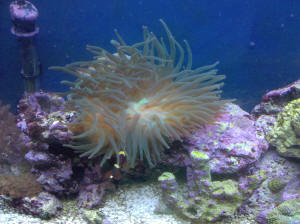 |
Re: re: Green bubble tip anemone
questions. 2/17/10
I thank you for your prompt response! I will try different feeding
arrangements and see what my results are : -) thank you for your
time.
<Ahh, welcome. BobF> |
|
White banding on Rose Anemone 10/7/09
Thought maybe you could take a quick gander.
<I have>
My rose anemones (the 2 pictures are of just one of them) have
white spots/banding. What's up w/that? They've been like
this for awhile.. ( year + )
<I don't know. Have seen this before... Is this de-
discoloration an indication of... disease? A lack of nutrition?
Just genetic expression? A beginning of riches for you from a
cloning biz?>
Never saw anything like it and Google didn't report back
anything'¦
Thanks
Carol
<I wouldn't be concerned... Bob Fenner>
|
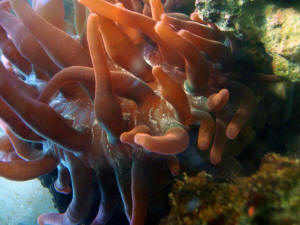 |
Hiding Anemone 8/1/09
Good morning.
<Tina>
I have spent a lot of time reading your site and have found it very
helpful. It saved me a few times from buying something that would
probably just starve to death in my tank. I have 2 bubble tipped
anemones
<Hopefully clones...>
that I bought attached to one rock. They have been in my tank for 8
weeks and one of them is perfectly fine.
<The winner>
The other crawled under their rock 2 days ago and has not emerged
since.
<The loser>
2 days before it went into hiding, my splash guard fell in the tank
right near it. It looked fine and even ate the next day after that. My
tank has been up and running for about 5 months. I have a 55 gallon
with 220 watt T5 lighting, powerhead, protein skimmer, hang on the side
filter, 5 gallon refugium (with algae and DSB), 2 inches aragonite
sand, 30lbs live rock. I have 2 false clownfish, 1 yellow tang, 1 blue
devil, 1 cleaner shrimp, 1 anemone crab and 1 snail. My ammonia,
nitrite and phosphates are 0. My nitrates are under 10. My calcium is
around 330. My KH is about 10, my pH is 8.3, my salt level is 1.024.
The temperature is 80. Should I try to look under the rock to see if
the anemone is ok?
<I would not>
Or should I flip the rock to try and put it back in the light?
<Nor this>
Please let me know what to do.
Thank you so much for your help.
-Tina
<IF they are clones and you're determined to try and keep two
Entacmaea in this system, I'd leave them both be... but if they are
not clones I would not attempt this period. IF they are not
clones/genetically identical, it is unlikely the one will survive... in
which case I'd see the Net re means of moving one off the rock
entirely (perhaps the "ice-cube" trick)... and see it placed
elsewhere. Bob Fenner>
Re: Hiding Anemone 8/3/09
Good morning.
<Tina>
Thank you so much for your help. How can?
<??>
one tell if 2 Entacmaea are clones?
<Either from the dealer/supplier, observing the splitting oneself,
or their apparent behavior toward each other... Have you read here:
http://wetwebmedia.com/marine/inverts/cnidaria/anthozoa/bubbletipanemones.htm
and the linked files above?>
The? anemone that was hiding did finally come out and move to a
different spot on the rock, but they are both still on? the same? rock.
Though at this point, both look healthy.
Thank you again.
-Tina
<Welcome. BobF>
|
Algae on Anemone: Bleached Anemone Making a Comeback.
Anemone Health\Reading 6/28/2009
Hello,
<Hi Brian.>
I have a Bubble Tip Anemone, it is white and has purple tips.
<Bubble Tips should never be white. White indicates it has
lost most of its symbiotic zooxanthellae.>
I have had it in my tank for about 7 months. It appears to be
opening normally when the lights are on. I don't feed the BTA
specifically but I feed my tank daily with Superveggie
flakes.
<Some target feeding will definitely help a bleached anemone.
Do read about their care here, and on the linked pages on top of
this page.
http://www.wetwebmedia.com/marine/inverts/cnidaria/anthozoa/bubbletipanemones.htm
>
I have a 120 gallon mixed reef tank. I recently had a problem
with Cyano algae but I think that the media in my Phosphate
remover was getting old and causing some problems. It appears
that the Cyano has stopped growing.
My water health appears good and my nitrates are 0ppm.
<OK>
Over the past month my BTA has started growing what looks like
algae (brownish/red) on the tentacles. I have attached a pic. It
doesn't look good, can you give me you thoughts on what is
going on?
<Based upon the pictures, it is regenerating its
zooxanthellae. This is a good sign.>
Please read the linked article above and give this article a read
as well:
http://www.wetwebmedia.com/acclimcoralslight.htm >
Thank You,
<My pleasure.>
Brian
<MikeV>
|
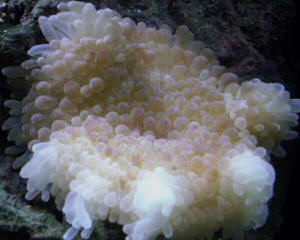 |
RBTA lost Bubble Tips 4/29/09
Hello, thanks for the wonderful resource. I love and abuse this site as
much as possible.
<If you love it, try not to abuse it.>
This is the first question, I could not find an answer too. I have had
a green bubble tipped anemone and also now a rose bubble tipped
anemone, both of which had bubbles for about two months, and then
magically decided to do the wide open mouth thing.
<Yes this happens sometimes, the mechanism for it is not well
known.>
I assume that my clownfish abuse there anemone like I do to this
website, is that possible? What kind of anemone can withstand that?
<Clowns can abuse their anemone at times, but as long as the anemone
is opened up and properly colored I would not stress about it loosing
the bubble tips.>
I have a female wild caught true Percula about 3.5 inches long, and a
smaller tank raised true Percula about 2 inches long.
They lost interest in the anemone now and are allowing the mushrooms in
the tank to hose them.
<This can happen sometimes, no big deal.>
Please let me know what is going on.
<Unless the anemone is showing other signs of stress, I would not be
worried by the bubble tips disappearing.>
<Before writing WetWebMedia again please take the time to correct
spelling and grammatical errors.>
<Josh Solomon>
Re: RBTA lost Bubble Tips --
4/30/09
I am wondering why after a few months the mouth opens all the way up
and then dies about a month later
<There are a bunch of reasons the Oral Disk can expand and close,
changes in flow and light will cause these changes in morphology as can
changes in feeding regimes. It sounds like this is a regular cycle for
your anemone and as long as it continues to "recover" back to
its normal morphology I would not worry about it.>
<Josh Solomon>
Green bubble tip anemone
BTA Splitting 4/26/09
I bought a bubble tip 2 weeks ago.
< Lovely animals for the more experienced aquarist. >
She had been doing great.
< Good to hear. >
The last 3 days she has been acting strange by not letting the clown
near her and staying closed.
< Not a good sign. The hosting anemone should be at least 3 times
the size of the clownfish. >
I then noticed she had reproduced.
< Hmmm... stress induced? >
Now she has gone dormant but still good in color.
< Dormant..?? >
The water conditions, lighting and circulation is fine. Am I doing
something wrong? Please help I 'd hate to loose her.
< Anemones are delicate animals and should only be kept in aged
tanks by experienced aquarist. The "reproduction" was a
survival instinct brought on by stress. The trigger could have been one
of many things or a little of all of them. New environment, shipping(if
ordered online), size and/or aggressiveness of its guest clown could
all have a hand in its stressed condition. The "dormant" look
is most likely caused by the recent
splitting. If lighting and water quality are up to par as you say it
should recover quickly.>
Many Thanks Machell
< You are quite welcome ... G A Jenkins>
|
BTA splitting or dying? 4-6-09
Thank you in advance for your assistance! I purchased a green BTA
at my LFS four days ago and have it in my 30-gallon QT. All of my
tank parameters are within normal limits: nitrates=0,
salinity=1.025,
temperature=78 degrees, pH=8.3. I have a 150-watt MH lamp on this
tank. I have never had a BTA split before. After searching your
site for information, I am at a loss and would like a
"professional opinion." I
know that a "gapping" mouth is a bad sign. I have read
when a BTA splits it begins at the mouth. I cannot decide if mine
is sick or splitting. I have attached a photo. I bought this on a
Friday, and the LFS is closed
Sunday and Monday so I have not been able to contact them yet. I
am just worried. Deb L.
<Hello! From your picture it looks like you BTA is splitting!
Since you bought it on Friday it could be splitting from the
stress so try not to disturb it much. You are welcome! Merritt
A.>
|
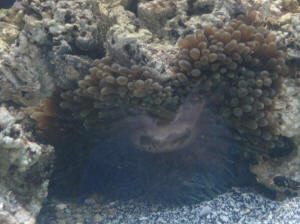 Mmmm. RMF Mmmm. RMF |
E. quadricolor Behavior Observation
3/30/09
Dear Crew,
<Joe>
Thanks again for the ongoing commitment to aquatic life! The dailies
are one of the high points of my day!
<Glad to hear.>
I don't have a question today but wanted to share with you and your
readers an interesting observation.
<Always welcome here.>
Several years ago I got the idea (from WWM) to remove my anemone from
my reef and to set up an 'anemonarium', housing several bubble
tip anemones. I am totally sold on the idea of keeping anemones in
their own system- it's really the most appropriate way to keep them
IMO.
<Very much in agreement with you.>
I have on two occasions (in two different systems) held large wild
caught bubble tips along with smaller specimens from divided anemones
either from my own tanks or from friends. In both of these systems I
noticed this interesting behavior: on occasion, the smaller
'clones' would move quite unexpectedly to a location very near,
or even touching the large wild caught anemone. In one tank, a 2'
specimen traveled from the far right side to the far left side next to
the large anemone in less the two hours. This was almost a 48'
distance! On another occasion, a small anemone moved from a location of
bright direct light and vigorous current to a much less favorable
location directly below a large anemone. The anemones have never
damaged each other from contact, in fact, they almost seen to enjoy
interlacing their tentacles!
I would guess that anemones can sense what it is their vicinity and
that perhaps, they are more social then we realize.
<Is likely the ideal location in the tank where the light/water
current are in favor of the anemones.>
Thanks!
<You're welcome, Joe, and thank you for sharing. James (Salty
Dog)>
Joe
Bubble Tip Anemone Question, not looking
too smurfy 01/13/09 Hello Crew! I wanted to let you guys know
how helpful the site has been to myself and fellow reefers. I recently
purchased a Rose Bubble Tip Anemone(RBTA).Unfortunately, the delivery
was a bit longer than planned. It spent 2 days in the mail. Upon
receiving it I started a slow acclimation over a few hours. After
acclimation, I placed it in a QT tank filled with water from my display
overnight for observation. It didn't look to smurfy and I wanted to
be sure it was going to be OK before placing it in my display. The next
day it had inflated, still had color and was attached to the bottom of
the QT tank. I gently removed the RBTA and placed him in my display,
where he almost instantly attached himself to the rock formation I
built for him. I have tried to feed him some small pieces of krill with
little success. During the day he kind of pulls his body into the rock
with short bubble tips. During the night he fully inflates to double
the size with long tentacles. My question is this. Are these signs that
he is still adjusting after the stress of shipping and a new tank or is
this normal RBTA behavior? After reading on WWM I'd say he's
probably still adjusting but I wanted a second opinion. <I do think
it is likely just still adapting to its new home. The fact that it has
attached to rock and is inflating and retracting are good signs. I
would try feeding it at night when it is most extended... but do so
gently, and maybe with small pieces of krill or enriched brine
shrimp.> 30 gallon long Sundial T5s 4 X 39 watt Octopus NW-150
skimmer 20 gallon sump w/ small 'fuge About 35 lbs live Rock 3 year
old pair Ocellaris clowns(not hosting) About 700gph water flow I
removed most of the coral but still have some Palythoa colonies and a
small Monti Cap in it Activated carbon Calcium 400 DKH 8 Temp 79 PH 8.1
Salinity 1.025 Phosphates, nitrates, nitrites 0 BTW is it true that
Scott V is a swim suit model? <Well, he models it for us all the
time... but I think you might be thinking of E. Borneman who actually
was a male model before he got into reef keeping. ;-)> Thanks in
advance and keep fighting the good fight, Adam <Well, thank you,
Sara M.>
Entacmaea quadricolor Photo Response
10/16/08 Dear WWM Crew, <Joe> I wanted you to know that
in addition to the daily FAQ's, I particularly enjoy the daily
marine pix. <Ahhh! Gratifying... most all these pix are by me... and
takes considerable time to load, size, link... am glad to find you
enjoy them> The latest one of the beautiful Bubble-Tip anemone
triggered a response from me. I have been keeping Bubble-Tips for
several years with much success. They are a truly wonderful species and
perhaps that most suitable for aquarium life. I have had 4 distinct
specimens and each has displayed highly variable "bubbles" at
different stages of each one's life. Some have displayed huge ball
like tentacles for years while others started out with the bubbles and
have gradually changed to thin tentacles with the bubbles barely
visible. The last books I've read have had a few hypotheses for the
formation of bubbles (or lack there of) such as level of light,
feeding, or clownfish hosting. I was curious if you or any other crew
members have read any newer research on the subject that would shed
some light on this remarkable curiosity. Perhaps we're getting
closer to cracking this mystery. <I have read the same explanations,
speculations Joe... Don't really "see" any real positive
correlation though... the bubble-ness of tips seems more random>
Again, thanks so much for your dedication to the hobby as well as for
life in general on this wonderful planet. Joe <Thank you for
sharing. Bob Fenner>
Anemone Question, BTA reading
10/14/08 A little back round first, I have a 29gal BioCube,
that I have had up and running for about a year. my temp is at a always
82.2, SG is 1.023. <Too low> I have this bubble tip that I got
about 2 1/2 weeks ago and the strangest thing is happening with it.
During the day when the lights are on it looks like it is dead (see
attached pictures)
http://s170.photobucket.com/albums/u250/Baranovic/?action=view¤t=1007081830.jpg
http://s170.photobucket.com/albums/u250/Baranovic/?action=view¤t=1007081831.jpg At night when the lights are about to go out and all thru the night he
is open and looks great. (see attached picture)
http://s170.photobucket.com/albums/u250/Baranovic/?action=view¤t=1007082022a.jpg
http://s170.photobucket.com/albums/u250/Baranovic/?action=view¤t=1007082022.jpg
well maybe not great but better. anyway I someone told me my temp was
to high so I lowered it to 79.8 and I am still having the same issue.
Any suggestions as to why and what to do? <Yes. Read:
http://www.wetwebmedia.com/marine/inverts/cnidaria/anthozoa/bubbletipanemones.htm
and the linked files above... re feeding, water quality... Info. not
provided by you here. Bob Fenner>
Escaping Anemone! Beh., repro. 8/9/08 Hi,
<Brian> Thanks for your time and for this great service.
<Welcome> I have a 120 gallon FOWLR. The water has no measurable
nitrates or ammonia, the SG is 1.023, <A bit, too low> I have 480
watts of light from a T5 HO fixture (equal numbers of actinic and
10000k bulbs), and all appears to be well. There is a 30 gallon
refugium below the main tank with algae and live rock. I have a protein
skimmer running. About eights months ago, a rose bulb tipped anemone
split in two, which was fun to watch and I hope indicates that all is
well (or at least was) in the tank. Over the next several months,
everything was fine. About two months I moved to the 120 tank I now
have from a 75 gallon tank. About a month ago, for reasons that are
still a mystery, a new fish arrival in the tank killed all but two of
my fish through the introduction of ich and several bacterial
infections (like bulging eye, gill rot, etc.) This happened despite a
five week quarantine of the new arrival in a tank set up according to
the recommendations I found on this site. Before I removed the two
surviving fish to a hospital tank, I tried to treat with ?reef safe?
products <There are none of "these" that are safe AND
effective> and Metronidazole to no effect. So, now I have my
fishless display tank, in which all the remaining inhabitants (two
anemone as described above, four shrimp, an urchin, tons of snails, and
tons of hermit crabs of several reef safe varieties) appear to be doing
well in the fishes? absence. I am curious about the behavior of one of
the anemones, which is why I write. One of the anemones is located in
the center of the tank about 10 inches below the surface on a rock. I
appears to be very healthy, goes through the cycles of eating and
expelling waste, and has a terrific appearance. The other anemone
(which is obviously genetically identical) also appears healthy, but it
has migrated from a rock next to its ?sibling? to a corner of the tank
at the surface of the water. It looks fine, bit I am concerned about
its choice of location: does it indicate a problem? <Mmm, no... or
at least, not necessarily... Makes "sense" does it not, that
such behavior might take place, assuring distribution of the
genome...> How will I do a water change without having to either
move it or expose it to air as the water level drops? <Not really a
problem... i.e., I would go ahead and drop the water level... the
animal will move if need be.> Thanks!, Brian <Bob
Fenner>
| An ID Question (flatworm) and Anemone Behavior
Issues 6/27/08 Crew- <Craig> May I please get a positive
ID the first attachment? From what I have read, it appears to be an
Acoel flatworm of the genus Convolutriloba. <Is a flatworm
evidently> If possible, can we confirm what behavioral info you
might have and point me to it? <Mmm, not following you here...
what beh. info. re what?> Additionally, can you speculate that
these flatworms would be suitable prey for Chelidonura varians, the
"Blue Velvet" sea slug? <Might be... but if
they're numbers are low (enough) I'd ignore them> For
some time I have wanted to purchase one of these animals, but have
never went down that path since I knew they were specialized
predators that I could not feed on a consistent basis.
<Correct... and when prey numbers are low... it/they
"disappear"...> Right now, these flatworms are in the
midst of a population bloom in an aquarium that only has a pair of
percula clownfish in a BTA. I have added a pair of peppermint
shrimp, but they have not had an appreciable impact on the
population of flatworms. <Many are unpalatable... as you likely
are aware> Also, if these guys pose any risk to my aquarium
inhabitants or even my copepod population I would rather introduce
a predator or siphon them out. It seems that is the consensus of
the responses on WWM. <Okay; glad to find you've
searched> The second attachment is of a BTA I purchased about a
month ago. I wanted to contribute to the knowledge base about some
observations I have had with this animal. It is probably the 10th
BTA that I have owned - the others I have sold to other aquarists
after pairing various clownfish species and getting the pair to
host in the anemone - it's just something I enjoy doing.
It's often a challenge to pair clowns up (especially maroons)
and even more so to create to commensal relationship between clowns
and their host anemones. <Interesting... that you state/find
this symbiosis to be such, rather than mutualistic> I believe I
have read on the site that the behavior of BTA is more sedate than
other anemones; meaning that while all anemones can/do wander, BTAs
tend to find a rocky crevice and lodge their foot inside. <Mmm,
most so with successive asexual clones here> I have found this
behavior to be true of all the BTAs I have kept until I brought
this one home. THIS anemone wandered around all night for about the
first two weeks. Each evening it would fill itself up with water at
the end of the day and then it would go on trips around the
aquarium. Each morning I would move it back to the place I wanted
it to occupy and it would attach itself there for the day. I
thought, "Well, evidently the anemone will tell ME where it
wants to stay and I will like it." <Yes to the former,
hopefully so for the latter> Interestingly enough, the LFS had
it in its display tank and it had never moved the whole month or so
they had it; in fact, we had to chisel it out of the rockwork just
to get it home. Both my tank and the LFS run MH lighting: theirs a
250W at 10K, mine a 250W at 14K. I have about 15X water flow per
hour, the LFS had about half that. About a week after bringing it
home, I knew something was amiss with nocturnal roaming of the BTA,
so I went back to the LFS to check their water parameters. It turns
out they run their SG at 1.023 and my tank was at 1.025. When I
lowered by SG to 1.023, the anemone promptly returned to the place
I had been trying to keep it and it hasn't moved since!
<Interesting as well. Coincidence?> The third attachment is
of a carpet I bought the same day as the BTA. Could you confirm
whether it is S. gigantea, as I suspect? <Looks to be... on the
basis of the pedicle> It is in a different system than the BTA
and currently hosts a pair of black ocellaris clowns.... which is
very sweet. The SG of the system I found this guy in measured
1.028. I took most of the day I bought it acclimating it to 1.026
SG, which is the highest I feel comfortable keeping the tank at. It
was under a single 10K VHO bulb in a plumbed in 29G tank at the
LFS, <Much too low> now it's under 400W of MH in a 92
corner bowfront. Apart from its weak coloration, it looked great at
the LFS and I have to say it does look a little less turgid these
days than when I bought it (its tentacles are longer and not as
"plump", but it eats weekly and has NOT moved once since
I introduced it to the tank. I found this ironic since the guidance
on WWM indicates that carpets tend roam excessively. <Some do
when first brought in from the wild, but exceedingly rare once
settled. Heteractis magnifica are the kings of travel> I guess
we can try to observe general tendencies among species of aquatic
life but there will always be exceptions. <Well-stated> At
this point, I have a pretty keen eye to catch the behavioral cues
that anemones exhibit to show how they are doing in a captive
system. Would you suggest gradually letting the SG increase to
1.027-28 and see if the carpet really does prefer such a high SG?
<Mmm, no> Part of me feels like it should have settled in by
now and be looking better - I can say its coloration has darkened
significantly (since it has better lighting) but it doesn't
seem to be as large as it once was and I suspect the SG may be a
little too low for its liking. I am not worried it would die
tomorrow, but I am thinking long term here about what parameters I
need to stick to. <Near natural seawater, NNS> I am sure that
had I not been reading WWM for years now and researching some of
the overarching principles of marine aquaria I would have at least
lost the BTA. I remember back in my early days I probably would
have been desperately trying to FIX something instead of focusing
on stability and incremental changes, if needed. <Ahhh!> I
definitely wouldn't have suspected SG. I wouldn't have even
considered that my instrument might need to be calibrated. I
definitely would have thought about ammonia, or even nitrate, as a
culprit....but not SG. So many thanks to all you at WWM for your
contributions to the many of us hobbyists out here. We are all
definitely made better for your efforts in what we do. Thanks!
Craig <Thank you for sharing as well. Cheers, Bob
Fenner> |
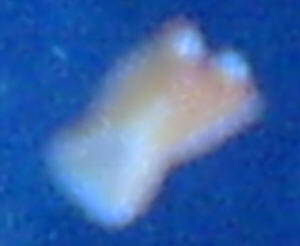 |
 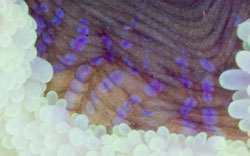 |
|
|

